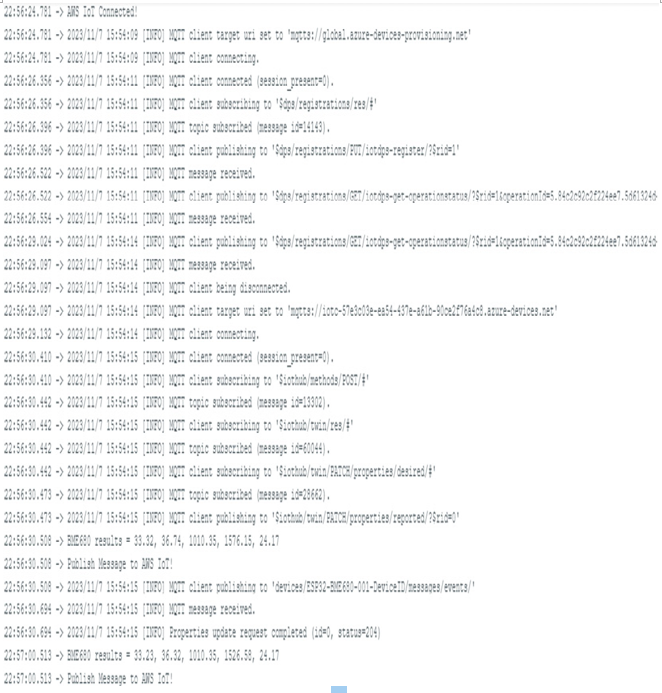Uploading the Arduino sketch and running ESP32 – Architecting Complex, Holistic IoT Environments
By Patrice Duren / September 5, 2023 / No Comments / AWS Certification Exam, Case study of Amazon, Managing threats and risks
With everything set up, we can upload the Arduino sketch and run ESP32:
Upload the Arduino sketch we created. After uploading the code to ESP32, it will restart, start connecting to our Wi-Fi, and try to make a connection to Azure IoT Central and AWS IoT Hub. It will read the BME sensor data and send it to both AWS IoT and Azure IoT Central. If we look at the Serial Monitor, we will find a message similar to the following:

Figure 14.13 – Output from the Serial Monitor
Once ESP32 is connected to Azure IoT Central, you will find that a device template called Espressif ESP32 Azure IoT Kit is automatically generated in the Azure IoT Central portal.
Next, you need to modify the data model. In the Device Template menu, select Model | {} Edit DTDL. Copy and paste the content of Azure_IoT_Central\Device_Template\Model\Espressif ESP32 Azure IoT Kit.json and click Save. Then, click Publish at the top.
Once the updated template has been published, navigate to Devices | Espressif ESP32 Azure IoT Kit | Adafruit Feature ESP32, then the device you created. You should see its Status change to Connected. Click on the Raw data tab; you will see the data with the latest data model uploaded from the device.
By following the preceding steps, you will have built a smart inventory management system with multi-cloud architecture using ESP32, AWS IoT Core, and Azure IoT Hub.
And that’s it! By following these step-by-step instructions, you have successfully navigated the complexities of a hybrid IoT deployment, assessed the potential threats and risks in the environment, and leveraged the benefits of multi-cloud architecture.
This hands-on experience has provided you with a deeper understanding of the concepts covered in the chapter on developing complex, holistic IoT environments. As you continue to explore IoT and multi-cloud technologies, you can expand upon this practical to develop more advanced and sophisticated applications tailored to your specific needs. With the foundation laid out by this exercise, you are now well-equipped to tackle the challenges of building complex IoT environments in the real world.
Summary
In this chapter, we delved into the development of IoT solutions for digital transformation within Industry 4.0, which has revolutionized the way industries operate. We have highlighted the importance of IoT in Industry 4.0 and explained the steps involved in developing IoT solutions to optimize processes, reduce costs, and improve productivity in organizations.
However, the implementation of IoT solutions can be challenging due to various factors, such as selecting the right IoT devices and sensors, data security, and training employees. To overcome these challenges, we have provided strategies for effective IoT implementation. In addition, we have included a case study on the use of IoT solutions in healthcare within a smart city. This case study demonstrated the potential of IoT solutions to create a more efficient and effective healthcare system.
Overall, this chapter aimed to provide you with an understanding of how IoT can be used to transform industries and drive digital transformation within organizations. By adopting the strategies outlined in this chapter, organizations can leverage the power of IoT to stay ahead in the rapidly evolving technological landscape.
Further reading
For more information about what was covered in this chapter, please refer to the following links:
Take a look at multi-cloud deployments: https://www.techrepublic.com/article/multi-cloud-deployment/
Understand how hybrid cloud models look like in AWS: https://aws.amazon.com/hybrid-multicloud/
Learn how to utilize Microsoft Azure for your own use cases through the official documentation: https://azure.microsoft.com/en-au
Get insights for multi-cloud architectures: https://www.synopsys.com/cloud/insights/multi-cloud-architecture.html
Understand the challenges and novel architectural models of multi-cloud native applications: https://journalofcloudcomputing.springeropen.com/articles/10.1186/s13677-022-00367-6